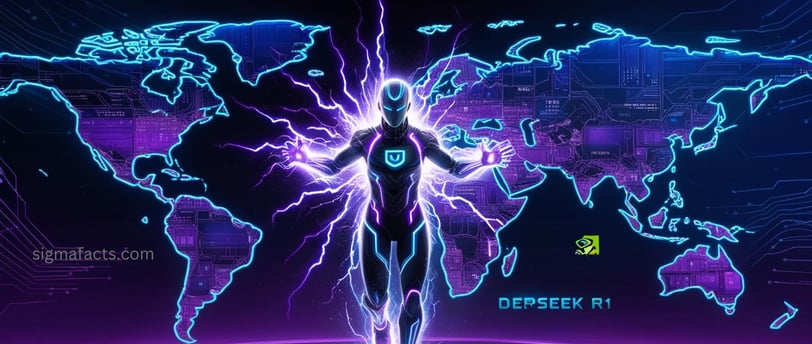
DeepSeek R1: How a Chinese AI Chatbot Shook the World
Explore DeepSeek R1, the cutting-edge Chinese AI chatbot with a Chain of Thought model and Mixture of Experts. Discover the Impact of DeepSeek R1 on NVIDIA stock and US tech market.
ACTIVISMTECHNOLOGYAI
DeepSeek R1: How a Chinese AI Chatbot Shook the World
On January 20, 2025, a Chinese research lab introduced a disruptive force in the world of artificial intelligence—a chatbot named DeepSeek R1. With claims of outperforming industry giants like OpenAI’s ChatGPT o1, Meta’s Llama, and Google’s Gemini Advanced, DeepSeek quickly captured global attention. In this blog post, we’ll explore how DeepSeek is redefining AI, its technology and architecture, its market impact, and what its rise means for the future of AI innovation.
A New Era in AI Innovation
DeepSeek R1 burst onto the scene with bold assertions: it not only outperforms its competitors in areas like mathematics, coding, and reasoning but does so at a fraction of the development cost. While leading American companies invest billions in AI research and development—with OpenAI charging as much as $200 per month for its ChatGPT o1 Pro—DeepSeek was trained for only $5.6 million and is available free of charge to users worldwide.
This dramatic difference in both cost and accessibility sent shockwaves through the tech industry. Within days of its launch, DeepSeek became the most downloaded app on the US App Store and Google Play, quickly topping the charts in India and beyond. The ripple effect was felt even in financial markets, with the US tech index reportedly losing a staggering $1 trillion in value—a loss partially attributed to the disruption caused by DeepSeek.
Impact on Markets and Industry Giants
DeepSeek’s emergence has not only challenged technological boundaries but also rattled financial markets. For instance, NVIDIA—a company long celebrated for its computer chips crucial in training AI models—experienced a dramatic drop in valuation. Previously valued at $3.5 trillion, NVIDIA’s market cap plummeted to $2.9 trillion in a single day, marking one of the biggest losses in corporate history. This decline highlights how innovations like DeepSeek can upend established tech ecosystems, pushing companies to rethink their strategies and investments.
Moreover, influential tech figures have taken note. A few months earlier, OpenAI’s founder Sam Altman had dismissed the notion that smaller investments—say, $10 million instead of $100 million—could ever lead to foundational AI breakthroughs. DeepSeek’s success, developed by a modest team at a fraction of the cost, serves as a powerful rebuttal to such claims.
The Visionary Behind DeepSeek
At the heart of DeepSeek’s innovation is Liang Wenfeng, a 40-year-old Chinese entrepreneur known for keeping a low public profile. With a background in finance and mathematics—having founded a hedge fund called High Flyer in 2015—Liang transitioned into AI research with the establishment of High Flyer AI in 2019. Driven by scientific curiosity rather than profit, he assembled a team of PhD students from China’s top universities to create an AI model that would set a new standard.
Within two years and with an investment of only a few million dollars, Liang’s team developed DeepSeek R1. Remarkably, the project involved just 200 people, 95% of whom were under 30—demonstrating that breakthrough innovation can come from lean, agile teams rather than sprawling corporate giants with thousands of employees.
Understanding DeepSeek’s Technology
DeepSeek is built on a Chain of Thought architecture—a design also employed by models like ChatGPT o1. This approach allows the AI to mimic human reasoning by “thinking” through a problem step-by-step before arriving at an answer. For example, when asked a seemingly simple question about comparing numbers, older AI models might provide a quick yet incorrect response. In contrast, DeepSeek carefully evaluates its thought process, even displaying its reasoning steps, which not only improves accuracy but also offers transparency to the user.
Another innovative feature is DeepSeek’s Mixture of Experts method. Instead of running one monolithic model to answer every question, DeepSeek splits its tasks across multiple specialized submodels. Whether you’re asking about engineering, medicine, or law, only the relevant expert module is activated. This selective activation means that while the full model has 671 billion parameters, at any given time only about 37 billion are in use—optimizing efficiency and reducing computational overhead.
Open-Source, Censorship, and Global Adoption
One of DeepSeek’s most attractive qualities is its open-source nature. Unlike some competitors that keep their models proprietary, DeepSeek’s code is publicly available. This openness allows users to download, modify, and even run the model locally on their own systems. Already, American companies such as Perplexity AI and tech giants like Microsoft have integrated DeepSeek into their offerings—removing built-in censorship filters to tailor the chatbot for different markets.
That said, DeepSeek is not without its controversies. The chatbot comes with built-in censorship on politically sensitive topics related to the Chinese government. For instance, if you ask about Tiananmen Square, criticisms of Xi Jinping, or other politically charged issues, DeepSeek responds with a polite refusal to engage. This aspect has sparked debate over the balance between open-source innovation and state-imposed restrictions, yet many users appreciate the flexibility of having an open codebase that they can adapt for their own needs.
Performance, Limitations, and the Road Ahead
Independent analyses have shown that DeepSeek excels in several areas—especially in coding, quantitative reasoning, and solving riddles. In some comparisons, it even edges out competitors like ChatGPT in quantitative tasks, though ChatGPT still leads in creative writing tasks like poetry. One drawback, however, is latency. While ChatGPT o1 averages around 31 seconds for a response, DeepSeek can take over 70 seconds as it meticulously processes queries. This delay is attributed to the surge in popularity, which has put additional strain on DeepSeek’s servers.
Nonetheless, the trade-offs seem to be worth it for many users, especially given the cost efficiency and the advanced reasoning capabilities that DeepSeek offers. By demonstrating that state-of-the-art AI can be developed with fewer resources and lower operational costs, DeepSeek is not only challenging established players but also inspiring a new wave of innovation in regions like India and beyond.
AI Wars and Global Innovation
The rise of DeepSeek also underscores a broader geopolitical and technological struggle. With the American government imposing export controls on high-end computer chips—vital for training modern AI models—Chinese companies like those behind DeepSeek have had to innovate using older hardware and more efficient algorithms. This necessity-driven innovation has not only leveled the playing field but also redefined what is possible in the realm of AI.
If China can achieve groundbreaking advancements with limited resources, then other countries, including India, have every reason to believe in their own potential for AI innovation. The DeepSeek story serves as both a wake-up call and an inspiration for nations and startups around the world to invest in research, focus on efficiency, and embrace open-source collaboration.
Conclusion
DeepSeek R1 is more than just another chatbot—it represents a paradigm shift in the AI landscape. By offering high performance at low cost, leveraging innovative architectural designs, and providing open-source access, DeepSeek challenges the conventional wisdom that breakthrough AI requires massive financial and technological resources. While it faces challenges such as higher latency and politically influenced censorship, its impact on markets, global AI research, and the broader tech ecosystem is undeniable.
Whether you’re an AI enthusiast, a developer, or a policymaker, DeepSeek’s journey offers valuable lessons about innovation, efficiency, and the evolving nature of technology in a globalized world. As AI continues to reshape every sector of society, the success of DeepSeek reminds us that sometimes, the most disruptive breakthroughs come from the most unexpected places.



